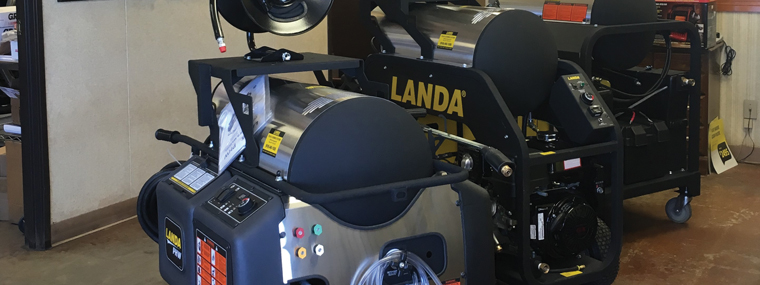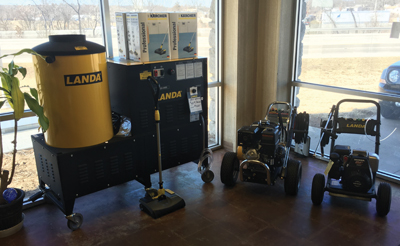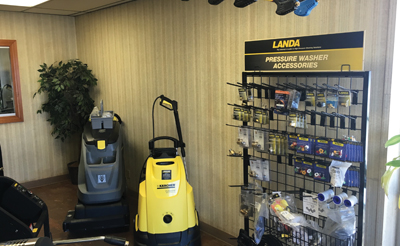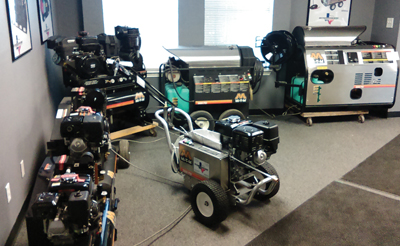
Setting Up a Showroom
By Diane M. Calabrese

Show don’t tell. Seeing is believing. There’s no substitute for firsthand experience. Whichever adage one favors, the message is the same: Prospective buyers like to be able to reach out and touch products before making a purchase. Digital connections are fast and convenient, but they still truncate our senses to the extent that we are never absolutely sure a product will meet our expectations. Showrooms remove any doubts—and do so much more.
For distributors, the showroom is typically a space in a bricks and mortar facility. Yet it also encompasses tradeshow exhibits, especially those that include demonstrations. The sophistication of illustrating the capability of any product may extend to taking equipment to a jobsite to allow a prospective buyer to try it, especially when a larger product is involved.
In short, the showroom matters, even in a digital age. “It’s still very important,” says Matthew Olinick, general manager at River City Pressure Cleaning Equipment in San Antonio, TX. “We have a lot of hands-on customers.”

With equipment in a showroom, it’s possible to connect with potential buyers immediately. “Some people walk in—you can explain ‘the what’ and ‘the why’ of equipment,” says Olinick. That explanation can be just what is needed to make the sale.
Fundamentals of setting up a showroom apply in-house and on the road. “It sounds like a cliché, but quality equipment—clean with good presentation—is a must,” says Olinick. Moreover, Olinick reminds us that the best equipment in the world will be diminished in the eye of the beholder if the showroom is dirty or dusty. A clean showroom gives the customer an immediate, good impression of a facility.
Beyond the basics, there are some other ways to make a showroom all it can be. “I believe in promotion,” says Olinick. “We always have cups, cozies, pens, and pads for the taking.” The takeaways have the logo and contact information for Olinick’s company on them. As such, they may bring in more business, even if the looker does not buy equipment that day.
Olinick has had service customers tell him that they were out in the field in need of assistance and were very glad to have his number on hand. The opportunity to service equipment purchased elsewhere may lead to a sale of equipment in the future.
Absolutely necessary content of a showroom is the availability of good, solid information. The knowledgeable staff is a part of the showroom at Olinick’s company. “We teach and preach knowledge at our company,” he says.
Setting high expectations and meeting them is the norm for distributors aiming to thrive in 2016. “It’s a competitive market,” says Olinick. The showroom is a component of successful outreach.
Content and Context
“The showroom is almost as important as the salesman,” says Dale Nicola, owner of Tulsa Cleaning Systems in Tulsa, OK. It provides a venue for helping the customer assess what he needs. There’s often a difference between what a customer needs and what the customer wants. With a thorough understanding of equipment, the customer can get the best match for his needs.
 Expertise of staff coupled with excellent equipment in a showroom setting ensures a good outcome for customers. “A customer can come in and look at what he wants or what he thinks he wants,” says Nicola. “We can show him the difference.”
Expertise of staff coupled with excellent equipment in a showroom setting ensures a good outcome for customers. “A customer can come in and look at what he wants or what he thinks he wants,” says Nicola. “We can show him the difference.”
The physical experience of being in the presence of equipment is different from the experience of watching a video of equipment in use. For one, more senses are in play. And, with a salesman present in real-time, questions can be asked and answered in genuine conversation.
The existence of a showroom sends a significant message to those interested in buying. “The customer can come in and see we have equipment on the floor,” says Nicola. “And we are truly in business to help them, not just show them pictures.”
A showroom should be sufficiently robust in content to allow sales personnel to literally show the customer the options available. Customers are motivated to make a purchase when they have been satisfied that they understand the product and know the product meets their needs.

The showroom should exist “to show customers all different levels of equipment that might meet their needs,” says Nicola. And its design should allow sales representatives to demonstrate the equipment. For example, an ideal showroom might include quick access to an outdoor area with a sanitary drain and various surfaces—brick, slate, wood, etc. on which equipment can be demonstrated. Such an arrangement allows demos to take place without going on site with a customer.
Balance is everything in sales, and in some instances, going on site with a customer to show the utility of a machine can be a good idea. For smaller machines, though, an area adjacent to the showroom can be more cost efficient when demonstrating.
Distributors that customize equipment may use the showroom setting as a space for explaining how a basic machine can be modified for specific purposes. When speaking about customization, distributors can stress that customization is not a do-it-yourself project for contractors. In particular, they can emphasize that using equipment in ways not intended voids warranties, and perhaps worse, it creates safety and liability issues for the contractor.
The concern about showroom visitors who come to soak up as much knowledge as possible and leave to search for equipment via the Internet is not unfounded. The scenario happens across economic sectors. Distributors counter it by promoting the service and expertise that goes with their sale.
It’s a given that distributors with showrooms also have an Internet presence. And, in some cases, customers will visit, learn, and finally make their purchase via the Internet. The showroom is an integral part of the total sales environment.
Complementary Contacts
So much is the showroom a part of the comprehensive approach to sales, that manufacturers, too, often have a showroom. It’s just another way to get the word out.

“As we are a manufacturing plant, we don’t have a big showroom for our products,” says Jan B. Karlsen, president of PSC Pressure Systems, Inc. in Concord, ON, Canada. “However, we do have one of our smaller, portable units and a small stationary unit in the purchasing and spare parts area.”
Again, the availability of products in three-dimensions is an assist to customers who evaluate and reevaluate their requirements. “We feel that if our local customers are, say, coming in to pick up spare parts and can see the smaller units, they understand the unit better than just us explaining it over the phone,” says Karlsen.
Just the immediacy of the experience with the equipment can lead to a sale. “Customers can make a quick decision on the spot to purchase and take the unit with them,” says Karlsen. “We have sold a few units this way.” Although they do occur, on-site sales are not common at Karlsen’s manufacturing plant. “We still have most of our customers contact us by phone or e-mail and receive their quotes this way,” he says.
Distributors and manufacturers determine through experience and trial the optimal arrangement of contact points. Internet and phone are universal. For many, a showroom is also in the mix. Because a showroom takes time and money to maintain, it ought to be put to good use. If foot traffic seems to be down, the availability of the showroom can be promoted through a seminar on a topic of great interest to contractors, such as wastewater collection.
By maintaining e-mail contact with customers, a distributor can also remind existing customers to drop by and see products and ask questions. On the side of allowing potential buyers to find the showroom, do not forget to mention the showroom on a website. Better still, include a picture. And definitely include a map. The easier it is to move from the virtual world to the real world, the more individuals will make the trek.
A showroom that realizes its full value—one that factors in the cost of the additional square footage and the maintenance requirements—will incorporate three elements:
- First, the showroom will speak loudly to the value of the products on display. The products will be presented with clarity, fully assembled. There will be no half-opened boxes or crates or other obstacles to moving around. Lighting will be good.
- Second, the showroom will speak for itself and also for a service department, if there is a service department on site. A showroom visitor should be able to see the service desk and service representatives who are engaged and professional. It will build confidence in the entire operation for walk-ins who are new to the facility.
- Third, the showroom personnel should speak with nothing less than exacting knowledge of the products. True, there will always be some questions that stump the most knowledgeable staff member. Such questions should be used to reinforce the can-do and will-do approach of the distributor or manufacturer when the answer is found and relayed as soon as possible. Show and talk, in other words.




